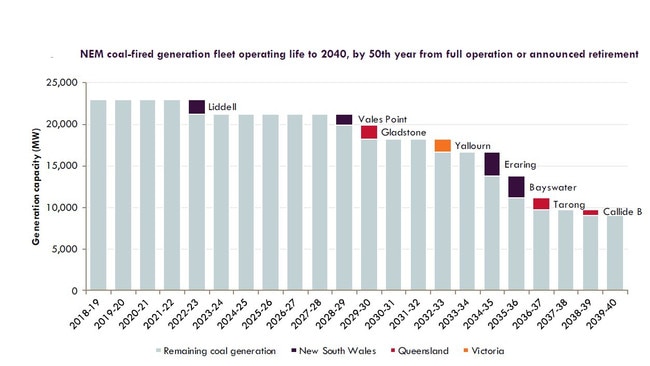SA’s multi-billion transition to green power
South Australia’s transition to 100 per cent net renewable energy is gaining pace as huge investments in storage will firm up power whether or not the wind is blowing or the sun in shining.
More than $16 billion of investments in renewable energy are on the drawing board as South Australia’s electricity transition enters the next phase.
After a decade and a half of building wind farms, the focus has shifted to grid-scale solar and huge energy storage projects.
This week the Crystal Brook Energy Park proposed by French company Neoen received development approval — the latest in a recent spate of projects to win government’s go ahead.
Neoen’s $500 million project has wind and solar to spread generation across different times of day and a battery three times the capacity of the Tesla array in Jamestown so it can provide firm power to major industrial customers.
“It’s the first time this has been attempted in Australia, around-the-clock power,” Neoen head of development in Australia Garth Heron said.
Also this week, the Australian Energy Regulator announced legal action against four SA wind farms over the 2016 statewide blackout.
The wind farms will defend the action but the move reignited debate on integrating renewables.
New projects are scattered around the state and include about 25 storage ventures, compared to just two in operation and one in construction now.
“The exceptional growth of renewable energy in SA is a testimony to how rich our state is in sun and wind resources,” Acting Energy Minister Rob Lucas said.
“Harnessing our renewable resources presents both significant opportunities and challenges for our state.”
Finance, as well as approvals, remain as hurdles for many.
Renewables players were ‘licking their lips’ at hope of Labor govt
“Not all the projects will go ahead,” said Guy Dundas, energy fellow at the Grattan Institute.
“What we’re seeing in SA already is that on a very windy, sunny day the wholesale price is very low.
“That’s a commercial signal to say there is only so much room left for more renewables.
“But people are positioning themselves now for two or three years time when the interconnector with NSW is likely to be built.
“That’ll give SA an opportunity to sell power into that big market in NSW — and when it’s not windy to draw power.
“So that allows SA to integrate more renewables without risking reliability.”
The Australian Energy Market Operator’s key planning document — the Integrated System Plan — foreshadows immense change across the National Electricity Market.
From 2030 to 2040, it expects half of the coal-fired power stations to close — requiring replacement for a third of total consumption.
AEMO says the lowest cost replacement will be from wind, solar, storage and gas-fired plants with flexibility to turn on and off.
It has designated renewable energy zones around the country to encourage an orderly build.
In SA, the Mid North is marked for wind and further north for solar because existing transmission lines have capacity.
It identifies the Riverland next, subject to transmission — which fits ElectraNet’s $1.53 billion Project Energy Connect to NSW.

Australian Industry Group chief executive Innes Willox sees new transmission as essential.
“There is a vast volume of renewable generation at some stage of proposal, permitting or development across the National Electricity Market — much more than the system is yet ready to absorb,” he said.
“There are two kinds of shortfall to remedy.
“First, the transmission network is not strong enough or extended to the right places to unlock the largest, cheapest renewables options.
“Second, we are not moving as fast as we need to on flexible resources to complement variable renewables.”
Overall, “a combination of market reform and energy and emissions policy certainty” was needed, he said.
Since the 2016 blackout, reforms at state and federal level and business initiatives have aimed to smooth the transition.
These include:
• AEMO ensures a minimum level of thermal generation at all times.
• ElectraNet is building synchronous condensers which act as shock absorbers to ride through system instability.
• Neoen’s Hornsdale Power Reserve (big Tesla battery) at Jamestown is saving millions of dollars supporting frequency control.
• AEMO has enhanced intervention powers by declaring a “protected event” as it did on Thursday when SA experienced extreme winds.
• Virtual power plants of linked up home batteries are being developed.
• Rules are being changed to facilitate demand response.
• Retailers must have reliable contracts of supply.
• The SA Energy Minister has the power to direct generators to turn on.
The big build across the market will also affect the nuclear energy debate which was revived last week with the Federal Government calling a parliamentary inquiry.
Mr Willox said costs were an inhibitor but “there is no harm in a fresh look at nuclear, and industry has long supported removing the legal ban”.
“Nuclear has zero direct emissions and a strong reliability record,” he said.
However, Mr Dundas agreed there were a “lot of tricky issues” including legislative reform, skill development and construction that would take time to overcome even if nuclear was deemed acceptable.
“The gap in the market is really going to open up in the late 2020s, early 2030s (as cascading coal closures occur),” he said.
“Nuclear is just not in the race for that gap.”
Mr Dundas sees prices on a downward path in the short-term before a return to moderate increases.
“The system is adjusting to a new reality,” he said.
SOUTH AUSTRALIA’S RENEWABLE PROJECTS
